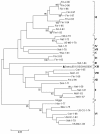An outbreak of aseptic meningitis caused by coxsackievirus A9 in Gansu, the People's Republic of China
- PMID: 20367886
- PMCID: PMC2907575
- DOI: 10.1186/1743-422X-7-72
An outbreak of aseptic meningitis caused by coxsackievirus A9 in Gansu, the People's Republic of China
Abstract
Background: An outbreak of aseptic meningitis occurred in Tianshui city of Gansu Province, the People's Republic of China, from March to June 2005. A total of 85 patients were clinical confirmed as aseptic meningitis in this outbreak.
Results: CVA9 was mainly responsible for this outbreak supported by the clinical manifestations of the patients, epidemiological data of the outbreak, the results of RT-PCR and complete VP1 sequence determination, conventional neutralization assays, IgM serological assays, viral isolation and phylogenetics analysis. Through phylogenetic analysis and homogeneity analysis for partial VP1 gene, the nucleotide and amino acid homologies between Gansu isolates and former Chinese CVA9 strains were 88.2%-96.1% and 97.2%-99.2%, respectively. Multiple transmission chains of CVA9 occurred in different provinces or years in China. Moreover, in order to clarify the genotype of CVA9, Gansu CVA9 strains isolated in this outbreak were compared with other CVA9 isolates based on VP1/2A junction regions (genotyping region) and they might belong to a new genotype of CVA9, which could be assigned for genotype XIII, CONCLUSIONS: CVA9 was confirmed as the pathogen responsible for this outbreak. The phylogenetic analysis indicated that the CVA9 strains isolated in this outbreak might belong to a new genotype.
Figures




References
-
- Stanway G, Brown F, Christian P, Hovi T, Hyypia T, King AMQ, Knowles NJ, Lemon SM, Minor PD, Pallansch MA, Palmenberg AC, Skern T. In: Virus Taxonomy Eighth Report of the International Committee on Taxonomy of Viruses. Fauquet CM, Mayo MA, Maniloff J, Desselberger U, Ball LA, editor. London: Elsevier/Academic Press; 2005. Family Picornaviridae; pp. 757–778.
-
- Oberste M, Schnurr D, Maher K, al-Busaidy S, Pallansch M. Molecular identification of new picornaviruses and characterization of a proposed enterovirus 73 serotype. J Gen Virol. 2001;82:409–16. - PubMed
-
- Khetsuriani N, Lamonte-Fowlkes A, Oberst S, Pallansch MA. Enterovirus surveillance--United States, 1970-2005. MMWR Surveill Summ. 2006;55:1–20. - PubMed
Publication types
MeSH terms
Substances
Associated data
- Actions
- Actions
LinkOut - more resources
Full Text Sources

